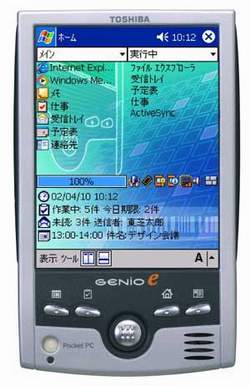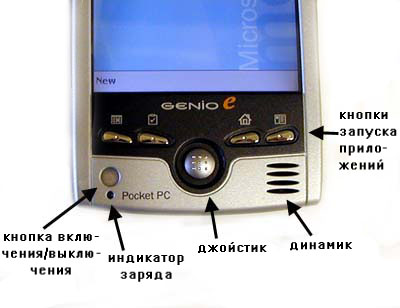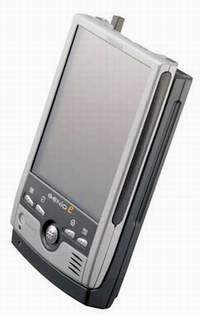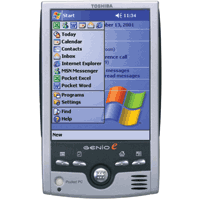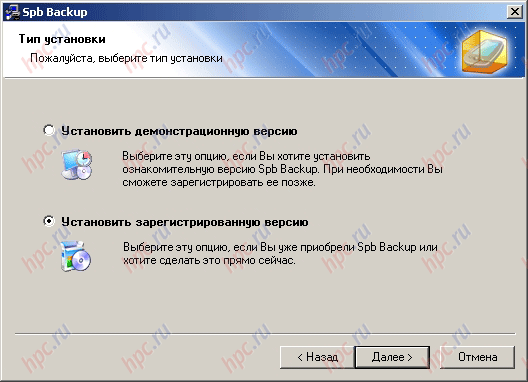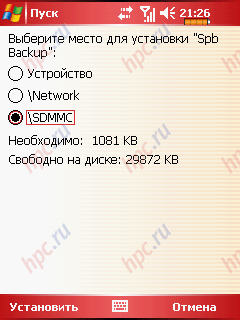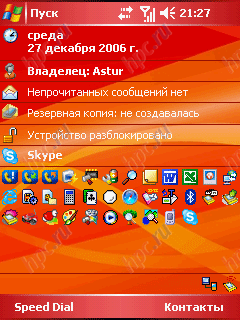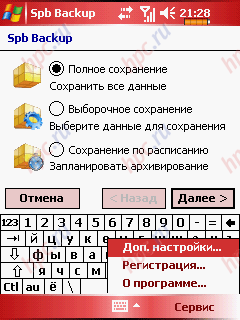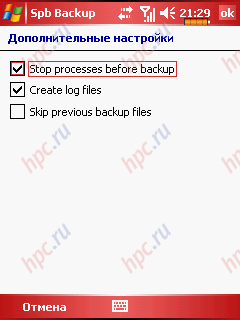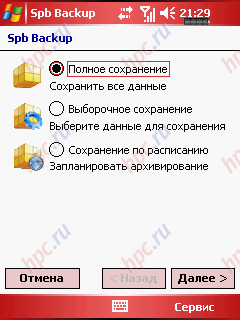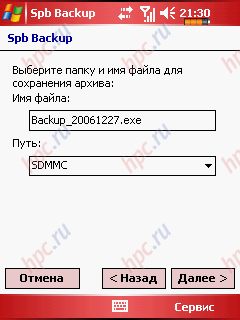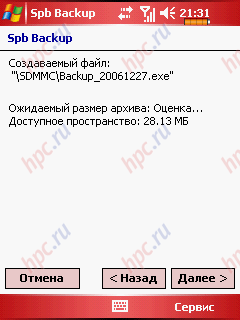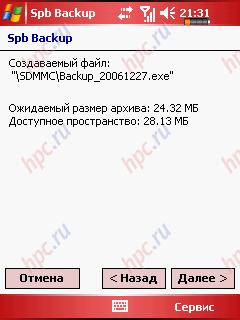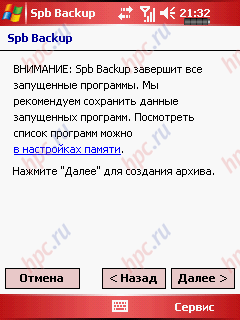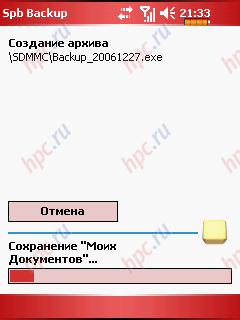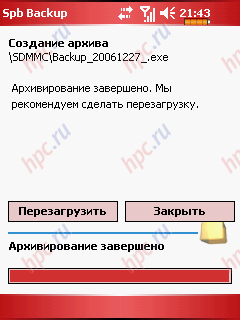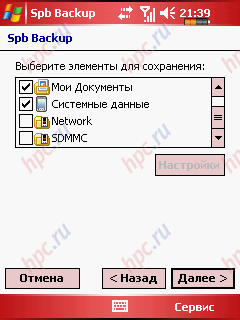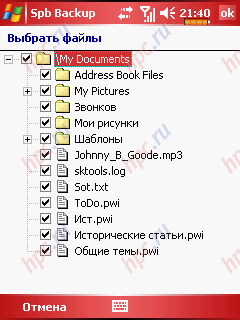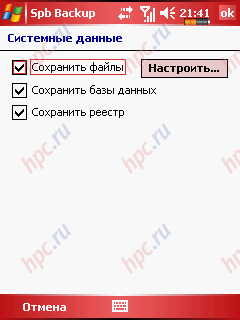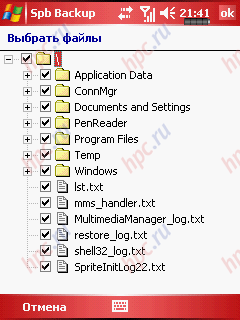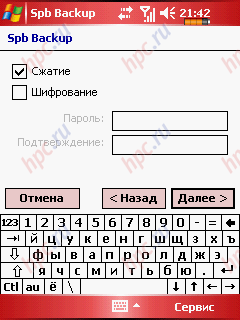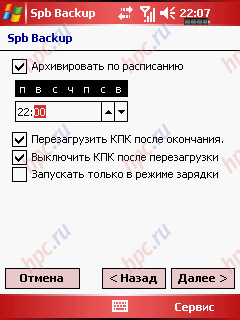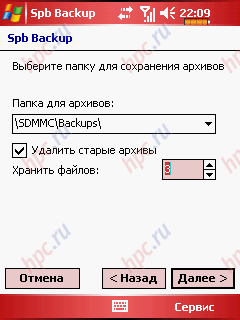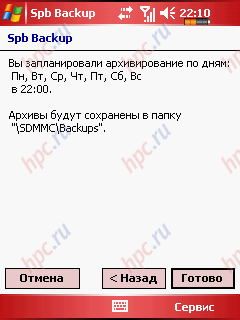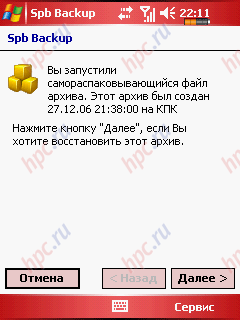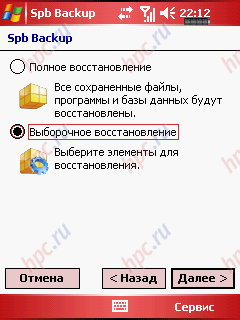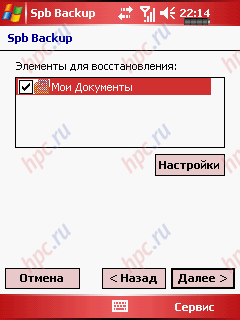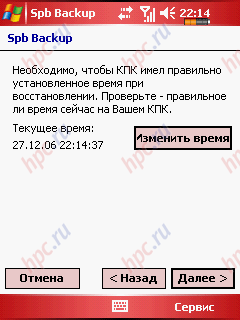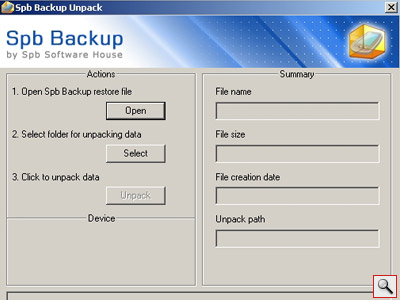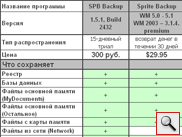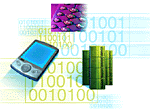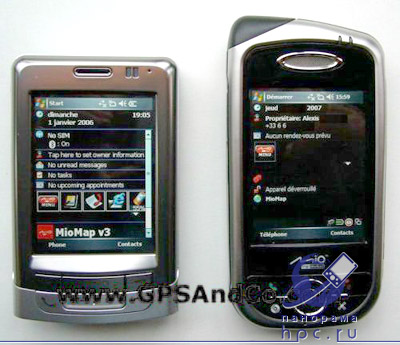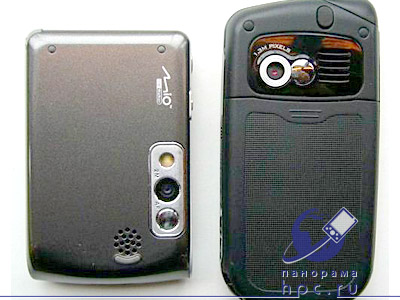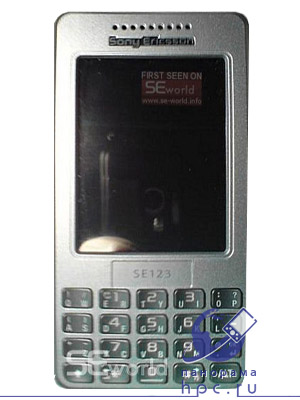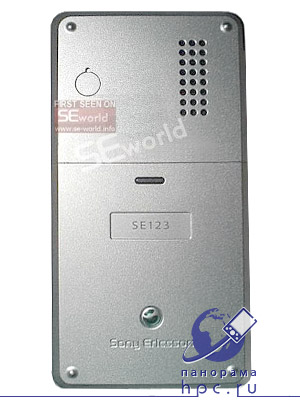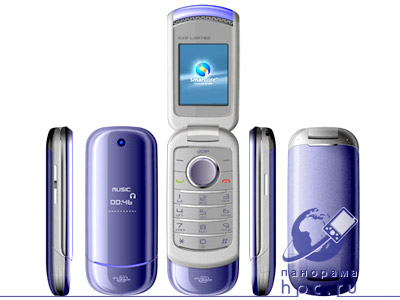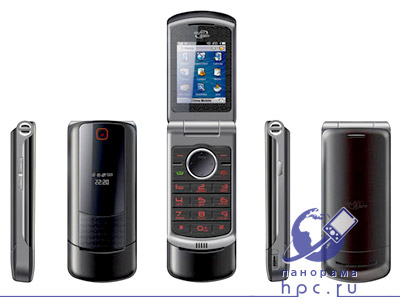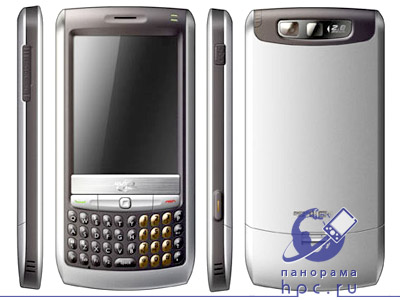The bulk of the news this week could be described briefly: in the footsteps of 3GSM Congress. " Information about new products, presented in this exhibition, continued to arrive, as rumors began to appear, and details about the updates that have not been adequately described and characterized by the producers themselves. However, it began to appear and groundwork for the future, manufacturers are already preparing for future exhibitions, for example, in March, CeBIT 2007 will take place.
ASUS Pegasus aka P526 out of the shadows
Rumors and preliminary information on the new Communicator ASUS Pegasus P526 or some time ago began to emerge in the network. It should be noted that this information was quite controversial and ambiguous. Last week the company ASUSTeK Computer, finally, gave the first official data on its subject. Among the products to be showcased at CeBIT, the company said, and this device. Details are scarce, basic details will be announced during the upcoming CeBIT 2007, which will be held from March 15 to 21 in Hannover. Now we can say that ASUSTeK has confirmed much of what was previously in the preliminary information. First, the model is indeed called the ASUS P526 and it really is a communicator with a numeric keypad, which continues a worthy cause model P525. To control can be used more and wheel JogDial. Communicator also has a touch screen, though smaller than usual and than expected - the diagonal is 2.6 inches and 2.8 inches is not like a P525. In this case, parameters such as resolution and color standard - QVGA (240x320 pixels) with 65K colors. Communicator has vostrennuyu support for GPS-functions. The device is thin (15.4 mm) and very light for its capacity - at ASUSTeK listed weight of 115 grams, it's probably still without the battery. For comparison - P525 weighs 160 grams, given the battery. Another unusual, is alerting the rumors and that was confirmed by the manufacturer, this device's ability to operate in four frequency ranges networks GSM, maintaining standards of data transfer such as GPRS and EDGE. Models from ASUSTeK have traditionally suffered from lack of support for EDGE, as we see, the manufacturer is working to improve the communication parameters of their products. The camera uses a 2-megapixel with video recording capability. The assumption that appears in this model, the new operating system is also confirmed - ASUSTeK said Windows Mobile 6, which was presented at 3GSM. Official images of the company has not yet published. It is also not yet clarified many important moment, for example, a processor is used and whether there is support for wireless networking Wi-Fi. According to earlier rumors, the processor does not possess special shustrostyu (TI OMAP 850 CPU at 200 MHz), moreover, assumed a possible lack of Wi-Fi. The latter point is not refuted by the manufacturer, but so far not submitted complete specifications to be sure this can not be marked minus. Well, the situation will become clear soon enough - CeBIT is coming.
Benefon enters the market with three Windows Mobile GPS-communicator
The company Benefon was well known at the dawn of mobile communications in the early telefonostroeniya when she released phone networks NMT, and later GSM. But then she came a long period of calm in the area, which lasted until last year. During this period, the company shifted focus on GSM / GPS equipment, more aimed at the professional sphere - providing security, the military and navy. Last year at the 3GSM World Congress the company introduced a new brand for navigation devices, TWIG, again intended for personal use. In the last year began selling the first phone under this brand, which, naturally, supported the GPS-functionality. Novelty called TWIG Discovery. Now the company has decided to expand its portfolio of three communicators based on Windows Mobile. Until the information is not very detail, also has not yet been published, and images of future innovations. Most logical to assume that Benefon communicators demonstrate at the March at CeBIT 2007. Let us consider more carefully what is said about them company. Conceptual models boast names TWIG Talisman, TWIG Totem and TWIG Monolith.The first model, TWIG Talisman, is one of the first GPS-devices, which will be issued on the basis of the new operating system Windows Mobile 6. According to the company, the model is perfect for business users, it is compact and looks like a normal mobile phone thanks to the traditional numeric keypad. The communicator display touch screen, but small for the navigation model, diagonal is 2.6 inches. Twig Talisman is designed for use in networks GSM / GPRS / EDGE, supports three frequency bands. Also in the arsenal of the communicator 2-megapixel camera, support Bluetooth 1.2 interface and, of course, GPS-module based on the chipset SiRF Star III. About the second device company did not specify what kind of operating system will be used, but the mention of a full PDA-functionality, including package and Microsoft Office Mobile, does not leave much room for doubt. The model also has a touch screen, though the size is not specified, and the numeric keypad. The main feature of this device are more extensive communications capabilities, including 3,5 G-standard HSDPA. According to the description Benefon, it is compact and lightweight. The camera on this model better - 3-MP also supports interface Bluetooth 2.0. Last Benefon announced new product - TWIG Monolith, the only one of all the Trinity, for which claim to support wireless Wi-Fi networks in addition to cellular networks. From what conclusion is that for the previous two novelties such an opportunity in an integrated form was not provided. This somewhat reduces their chances of success, because at the end of last year appeared a decent number of communicators that combine GPS-functionality with built-in Wi-Fi. For TWIG Monolith, as well as for TWIG Talisman, declared the work of running the operating system Windows Mobile 6. Aside from Wi-Fi, then the currently-known possibilities for the most part coincide with the TWIG Talisman. The model is equipped with a touch screen, numeric keypad, 2-megapixel camera, GPS-module based on SiRF Star III chipset and supports Bluetooth 1.2 As promised Benefon, the first model of the trio will go on sale in the summer, in June, while sales of other start for the second half of 2007. All three new products include a new navigation system from Benefon, which provides, including voice-step instructions in real time. At this stage it is difficult to say with whom it will compete novelty, in view of paucity of information on this point. However, as a possible competitor TWIG Talisman can be called ASUS P526, the alleged possibility of which generally coincide with the novelty of Benefon. The rest will become clear when a large detail of updates.
The Japanese release device with WVGA-screen
Another interesting novelty introduced, Sharp for the Japanese market. It's called the EM-ONE, and the manufacturer is marked as S01SH. Communicator is designed for operator Emobile, which in itself is unique, as the first new operator, licensed by the Japanese government over the past 12 years. EM-ONE - this is another model from this manufacturer that works on the basis of the operating system Windows Mobile. Recall that in 2005 Sharp excelled, producing Japan's first Windows Mobile device, W-ZERO3 that was outright VGA-display and resulted in a series of models of this class. Despite the fact that the new product is intended only for the Japanese market, however, it definitely deserves attention.
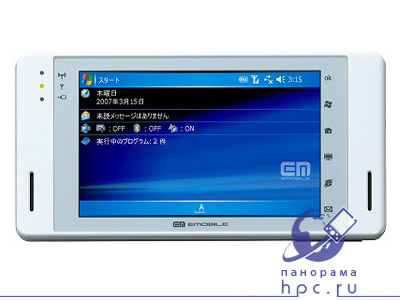 |
EM-ONE is a member of the tribe's small bilateral sliders, which still has quite a bit. On the one hand you can push the QWERTY-keyboard, this possibility has become very popular with modern smartphones like the HTC TyTN, the difference is that the "regular" mode for EM-ONE is clearly a horizontal, not vertical.If you move the keyboard part of the body sideways, then open the buttons to control media content, navigation menus, and so on, while on the reverse side of the camera lens is opened.
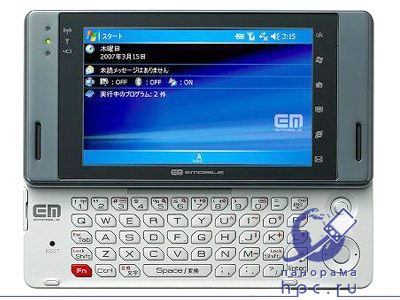 |
As usual, the Japanese did not skimp on the display. If the first W-ZERO3 display has a diagonal of 3.7 inches and a resolution VGA, then the EM-ONE display more advanced, it has a diagonal of 4.1 inches and at the same time supports a resolution of WVGA (800x480 pixels), larger than, for example, permit have announced at 3GSM World Congress HTC Advantage (X7500), whose screen diagonal of 5 inches. For devices running Windows Mobile operating system in version 5.0, is a special achievement, I hesitate to call a different model in this category with a resolution greater than VGA. It should be noted that the support of the VGA-resolution Windows Mobile also emerged relatively recently, only in Windows Mobile 2003 SE. At the same time under the new operating system, Windows Mobile 6 device with WVGA-screen already been announced - this is the communicator of the company's G900 Toshiba. True, the display had a smaller diagonal - 3 inches. On such a device, like EM-ONE, it will be convenient to watch a video and work on the Internet, most sites can be viewed without horizontal scrolling, it is especially important, given that the communicator is designed for use in high-speed standard HSDPA, based on which the operator starts service in late March.
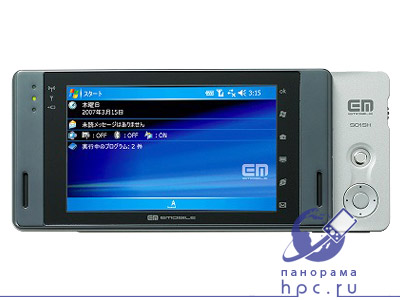 |
The rest of the communicator, too, is quite capable to make envy the Japanese. It works by using a processor Marvell (Intel) PXA270 with 520 MHz clock frequent and graphic accelerator NVIDIA GoForce 5500. Built-in memory of him a lot - 128MB RAM and 512MB ROM, it instead nabivshih nauseam 64MB and 128MB of RAM and ROM, have become standard recently. Plus, you can use a flash card format miniSD. MiniUSB connector provides USB-host function that provides additional opportunities for access to data on external drives. In addition to cellular networks, the device supports wireless networking Wi-Fi (802.11b / g) interface and Bluetooth 1.2. Dimensions of the model, of course, impressive - 140h70h18, 9 mm, affects a larger display and other advanced features. Weight is 250 grams, taking into account the battery and stylus.
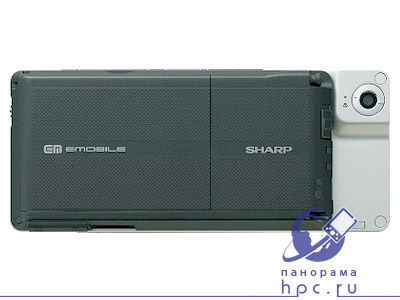 |
It should be noted that there has been significant progress in the development of displays for devices based on Windows Mobile. If last year you could easily count on one hand Windows Mobile communicator with VGA-display, then the top, their ranks replenished significantly, moreover, have been two announcements of communicators with displays support WVGA. An interesting trend emerges in the whole world, manufacturers have started to intensively produce quite powerful in its class of devices for mobile use, not zatsiklivayas in small sizes - the recent announcement of HTC Advantage (X7500) and the Nokia E90 is spoken in favor of this. Thus, the role of the mobile device as a real solution for mobile office and entertainment is gradually increased.
Ultimate: maximalist approach to communicators
At the 3GSM World Congress the company i-mate has announced a series of new communicators under the great name Ultimate. The devices in this series are distinguished form factor, some details of implementation, but have a common list of basic characteristics and a similar style in design. It is this range are common to all device parameters published Ultimate i-mate during the announcement.It sounds really tempting, the model should have a powerful and impressive. Judge for yourself, among them - the touch screen with VGA resolution, Intel processors with a clock common 520 MHz, 128MB RAM and 256MB ROM, and the new operating system Windows Mobile 6. Now the images found on the network devices in this series, with additional information about the features of each model, distinguishing it from the total number. The impression is that this is the result of leakage of information from the company i-mate. We can not say with certainty that they are one hundred percent untrue, and that their company will confirm when will release new items, but some of this information has already been confirmed in reports about the exhibition. For clarity, we list the general parameters declared for the series Ultimate:
- Operating system Microsoft Windows Mobile 6
- GSM / EDGE (850/900/1800/1900 MHz) and UMTS / HSDPA (850/1900/2100 MHz or 850/1700/2100 MHz)
- Touch screen with VGA resolution and 262K colors
- Intel Bulverde CPU with 520 MHz
- 128 RAM and 256 MB flash memory
- Slot for microSD memory cards
- 2-megapixel camera
- Stereo FM-radio
- XGA video output
- Wi-Fi (802.11b/g/e/i) and Bluetooth 2.0 EDR
- MiniUSB high speed
In the present site Todo Pocket PC for more information as mentioned in the list of common parameters Ultimate Battery capacity 1400 mAh.
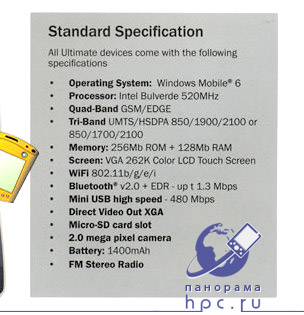 |
The first device in the series - Ultimate 5150 is a slider, but not with a side QWERTY-keyboard, which is already quite familiar to Windows Mobile smartphones, it's more like a regular slider phone with a numeric keypad. Oddly enough, but a similar form factor quite rare in among Windows Mobile devices. Display in VGA resolution has a diagonal of 2.8 inches, is the standard size for the now widely used QVGA-display. Dimensions Ultimate 5150 can not be called tiny, especially for a slider - 117h60, 6h19, 5 mm. But we must not forget about things such as, for example, support for HSDPA, which are implemented in it. For comparison, the smartphone O2 XDA Stealth, also referring to the mind of communicators in the form factor of the classical slider has dimensions of 110x53x23 mm display, but he at the same 2.4-inch, while the other parameters are also far less impressive.
 |
Communicator Ultimate 6150 - a classic candy bar without any numeric or QWERTY keyboards, but with the controls. Display, it also has the dimensions 2.8 inches diagonally. Like the Ultimate 5150, he was not small, the dimensions are 118.5 x60, 5x15, 7 mm. As indicative of his competitor can be called O2 XDA Flame. However, they are quite different, the main similarity is reduced to having a display with a resolution of VGA, but the emphasis is on an entirely different things. Thus, the display at XDA Flame is much larger diagonal of 3.6 inches, has 2 GB of internal memory ROM, but no support for third-generation networks.
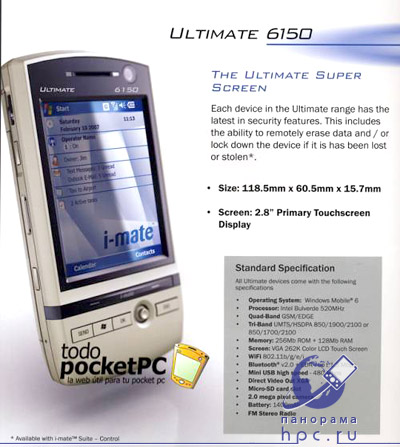 |
Ultimate 7150 - this is definitely a future competitor of HTC Universal. He performed in a similar form factor with unfolding the display, a little reminiscent of the notebook-transformer. Differences between them quite a lot. For example, the Ultimate 7150 appeared an external display, which lacked many fans of Universal. This display is 2.2 inches, executed on technology OLED. In addition, slightly increased the size of the main screen - up to 3.8 inches diagonally.In this case, unless the sources do not lie, which is unlikely because the information is consistent with the data from the mini-survey made at the show one of the visitors, the size of Ultimate 7150 is noticeably smaller than the Universal - 110x74x18 mm 128x81x25 mm against. In principle, such a change for the better quite logical, because the HTC Universal was released much more than a year ago, it was the first platform for smartphones based on Windows Mobile 5.0. Say as long as you can not change the weight, this value has not yet announced.
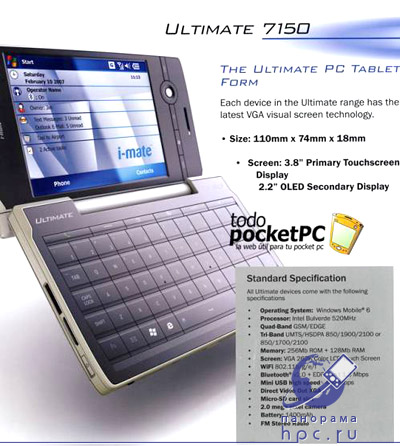 |
Ultimate Communicator 8150 - is a worthy successor to the idea of ASUS P525, managed to raise it to a new level. The model is a candybar with a numeric keypad. In contrast to the Ultimate 7150, this is not the bet on the big screen in this new product in front of it rather small - 2.6 inches diagonal, thus, as with all Ultimate, supports both VGA. Much more emphasis here is on small size. If you believe the source, the dimensions are just some 94h50h11 mm. For comparison, ASUS P525 which had the similar form factor display has a diagonal of 2.8 inches, dimensions are 116,8 x59x19 mm. Even allowing for smaller displays, such reduction in size seems a little suspicious and implausible, perhaps there crept an error. To draw definitive conclusions will have to wait for the official release, or at least detailed tests and reviews.
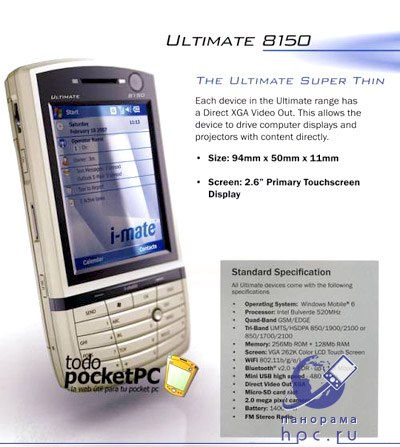 |
And, lastly, information about the model completes the series - Ultimate 9150. This is representative of a rare family of communicators, clamshells. Internal display touch screen, it has a diagonal of 2.6 inches and the legacy of the Ultimate resolution VGA. The external display is an auxiliary function, it is powered by OLED technology and has 1.2 inches diagonally. The combination of form factor and features it's definitely a unique device. In this case, the communicator is quite acceptable dimensions - 98h50h19 mm, more humane than the size, as compared, for example, with smartphones-clamshell N-series in which the dimensions happen to make 118h55, 5h28 mm.
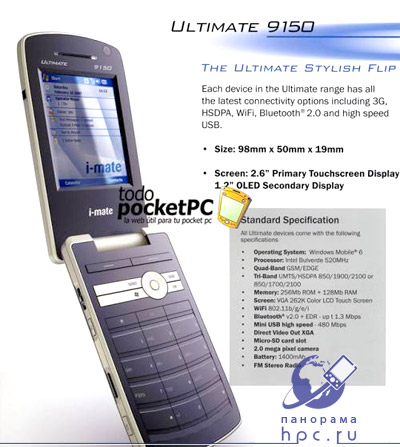 |
Summary. The company i-mate has all chances to rehabilitate himself, releasing the series. Recall that the case it were unimportant, after it in the middle of last year stopped releasing devices based on platforms developed by HTC. Actually, i-mate as would offer "Choose thee Ultimate taste", directing the attention of potential buyers to compare models Ultimate among themselves, rather than competing devices by other brands. A strong argument in favor of the i-mate is that she drew attention to many rare and often ignored by the producers wasted form factors. Note that in this case she has ignored such options as a side-slider and candybar with QWERTY-keyboard, which recently ceased to be a sign of elitism and are fairly common. Striking another interesting feature - none of the devices do not have such additional features such as integrated GPS-receiver or TV-tuner. Mainly focuses on the features of traditional PDA, the exception is perhaps that an integrated FM-tuner. In fact, in this way, Ultimate positioned as a device that is already good enough that would change one of them my old communicator. And not because he is a little better, but it has GPS, but because it is itself considerably, we can say even one order of magnitude greater than its predecessor. It should be noted that such positioning is largely justified.VGA-resolution, even at small sizes display promises many pleasant sort of sharper images, plus support for third-generation, plus a full set of communications capabilities with support for new versions of standards, plus a nimble processor and a decent amount of memory that can be especially important for new applications under the new operating system. As usual, the main issue in the price, which will ask for i-mate for them. Ultimate has a real chance to become a cult series of smartphones. It is expected that the first model of the Ultimate series will appear in the middle of this year.
GPS-communicator Mio A501: not so simple as it seems
The network has more details and live shots of the new navigation device from Mio A501 sufficiently known in the field of GPS-devices manufacturer MiTAC. While this information will not officially confirmed and is only provisional. Mio A501 is a compact device with a GPS-capabilities and 1GB of onboard memory ROM. Presumably, this is the main advantages of the model, otherwise it is quite modest and unassuming. Of the communication opportunities provided for work in four frequency bands of GSM networks with support for data GPRS and EDGE. Processor is modest - TI OMAP 850 CPU at 200 MHz. The display is slightly smaller than the already familiar to "just communicators" - diagonal not 2.8 inches and 2.7 inches for the standard QVGA (240x320 pixels). Probably including this explains the modest size - only 96x60x21 mm. However, it seems that it also slightly increased the width and thickness for the sake of reducing the height. To live photo you can see how much smaller Mio A501, than the older model Mio A701. Weight is small, but not outstanding - 135 grams.
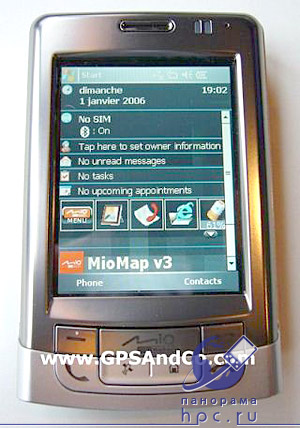 |
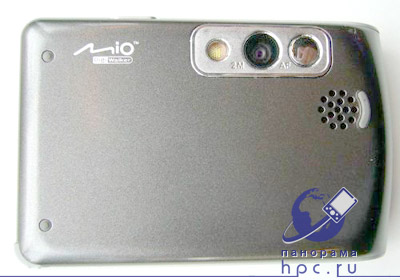 |
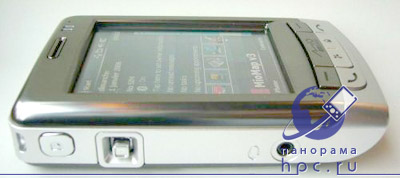 |
One of the main disadvantages of the model - lack of support for wireless networking Wi-Fi. In contrast, we should note the new support for EDGE, which is not, for example, have released last year model Mio A701, a much more advanced in many other parameters. The work done on the basis of the operating system Mobile Windows, but there is no accurate information on the used version - 5.0 or the new 6. Lovers of "good old" will certainly impress the memory card slot formats, SD / MMC, not newfangled microSD. Other parameters: a 2-megapixel camera instead of a modest 1.3-megapixel camera with A701, 64MB memory RAM, Support for Bluetooth 2.0. Battery is assumed to be too succinct - 1050 mAh, which may indicate the positioning of future innovations as a "car" models in favor of this and quite strong "square". At the moment, time to market, as well as the estimated price is not announced by the company.
Mysterious HTC P3400 showed up on FCC site
The history of the mysterious disappearance of the communicator HTC P3400 with the manufacturer's website will be continued. Recall that by announcing at 3GSM World Congress three new HTC Advantage X7500, HTC S710 and HTC P3350, HTC has published on its website information about another new device - HTC P3400, which was not mentioned in the press release. However, data on new product remained available to the public for long, a couple of days of data on the device has been removed from the site of HTC. Thus, clearly an error, and the company is either going to announce this product later changed her mind or does it produce. Last week about HTC P3400 has appeared in yet another reliable source - the site of the Federal Communications Commission (FCC). The model has received the go-ahead for use in the U.S.. Communicator is displayed on the FCC site, codenamed HTC Gene.
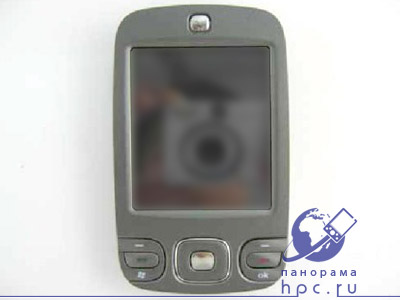 |
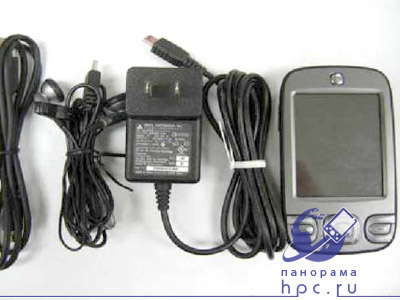 |
Curiously, in the materials published on the site FCC, it's mentioned support for wireless networking Wi-Fi, claimed earlier in the materials from the site of HTC. This can mean two things - either in a version that will go on sale for the U.S. market will be missing this opportunity, and this sometimes happens, but usually for models with advanced communications capabilities in third-generation networks, or, more likely, this feature just yet not been tested by the FCC and the information about it has not been published for this very reason. Recall that the HTC P3400 is a fairly simple by modern standards, Communicator, which was initially positioned the company as an available assistant businessman. Opportunity communicator strongly intersects with the model Qtek s200, but noticeably lighter, has no IrDA connector and is equipped with proprietary HTC ExtUSB. The very fact of getting approval from the FCC said in favor of an early release of the new items. We will monitor further developments in the history of the HTC P3400.
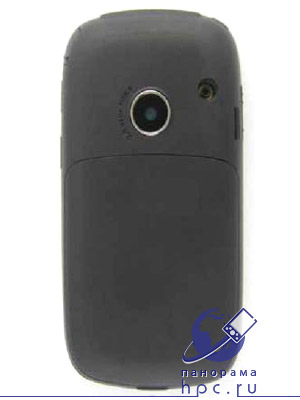 |
 |
Briefly about other events of the week
Lizy: a Sony Ericsson M600, with only Wi-Fi
The network showed up live pictures of the forthcoming device from Sony Ericsson. The model code-named Lizy aims to become the heir a well-known communicator Sony Ericsson M600, one of the first models on the UIQ 3 platform (operating system Symbian OS 9.1). Sony Ericsson M600 - a device made as a monoblock with the QWERTY-keyboard. It is expected that Lizy fill one of the major omissions committed in the M600, namely the lack of support for Wi-Fi. However, the lack of built-in camera future novelty and fail, for this purpose will be released yet another model. It is assumed that the integrated Wi-Fi module is the main difference Lizy from its predecessor. Nevertheless, one can see small changes in design, in addition, the model will likely be based on the updated platform UIQ 3.1. It is expected that Lizy to be announced in March at CeBIT 2007.
BlackBerry 8820: BlackBerry 8880, plus Wi-Fi
Not so long ago, was announced a new model device from the company Research In Motion (RIM) - BlackBerry 8880. Recall that it was expected model, which was accompanied by a sufficiently intense speculation. Almost immediately after the announcement renewed speculation by giving attention to a slightly improved model, which is expected to receive the support networks of Wi-Fi. It is assumed that this upgrade will be called the BlackBerry 8820.
The scandal with the iPhone brand is canceled: Cisco and Apple have agreed to
Came to an end the history of the dispute between the companies as Cisco Systems and Apple about the possibility of using the latest brand iPhone. We recall that shortly before the new year, Cisco announced a series of VoIP-products under the brand name iPhone, while Apple is in early January introduced its first mobile phone under the same name. Does not matter that Cisco stressed in opposition to Apple introduced its iPhone earlier series of phone Apple. The main thing is that, as it turned out, the brand owned by Cisco, not Apple. At the time of its iPhone, Apple has not yet reached an agreement with Cisco regarding the possibility of using the brand. At that Cisco is almost immediately responded by filing in court. On Wednesday, the company solemnly declared to have reached agreement on this issue. Under the agreement, both companies are free to use the iPhone trademark for its products worldwide. Both sides recognized the previously granted ownership of the trademark and renounced any claims to each other about it. Also, the company will consider possibilities of cooperation in the fields of security, consumer and corporate communications capabilities. Unfortunately, the rest of the nuances of the deal were left over, and declared confidential, including its cost. That way, everyone who wanted to enjoy the long scandal and a battle of giants will not get what you want. The company is clearly attracted the necessary attention to them at the time of the announcement of the iPhone and decided to not longer subject to abuse, despite the fact that from it could squeeze much more.
Testing anti-virus for smartphones
The Russian subsidiary of Panda Software, a well known developer in the world of technology, products and services in the field of IT-resources, today announced the beta application for protecting smartphones based on Symbian S60. Solution is called Panda MobileSecurity, it provides comprehensive protection against viruses, trojans, worms and other threats by scanning the internal memory, memory cards and the whole system. Application scans all incoming objects to any transfer mechanism: messages, files, digital postcards, coming to a smartphone for email, MMS, infrared interface or Bluetooth. As promised the developer, the final release will be realized the possibility of automatic updates and full technical support. The beta version of Panda MobileSecurity free.
Nokia N80 Internet Edition is already in Russia
In the Russian market started selling online versions smartphone Nokia N80, the appropriately named Nokia N80 Internet Edition. The main "trick" this version is that it pre-installed settings and applications they need to go to get started with some popular Internet services. Thus, the local search function is provided in Appendix Nokia Mobile Search, a Russian version includes the ability to search through Yandex. Also provides for fast download your photos to a server Flickr, and application Nokia Podcasting, intended to subscribe, download and listen to podcasts on an introductory podcast directory in Russian.
The regiment arrived Linux-Smartphone
The Chinese company E28 has expanded its portfolio of dual-mode Linux-smartphone. All it introduced five new models that support the work of both the GSM-network and Wi-Fi, while providing seamless roaming. With the growing popularity of converged services, this topical solution. Among the new products - two smartphone in the classic form-factor "monoblock» E2832 and E2831, E2861 clamshell and E2862, and E2881 candybar with QWERTY-keyboard. Except for the dual-mode and the operating system Linux, then its parameters are quite ordinary smartphones, most of them even simple. E2832 and E2831 are equipped with 2.2-inch display with QVGA (240x320 pixels), 1.3-megapixel camera (with E2832 camera do not), TI OMAP 730, at 32MB (E2832) or 64MB (E2881) ROM and RAM . Smartphone E2881, in addition to GSM (850/900/1800/1900 MHz) and Wi-Fi (802.11b / g) interface supports Bluetooth 1.2, and is also equipped with a slot for memory cards microSD.
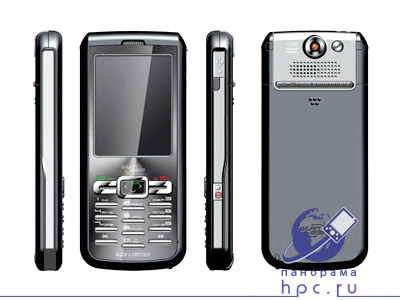 |
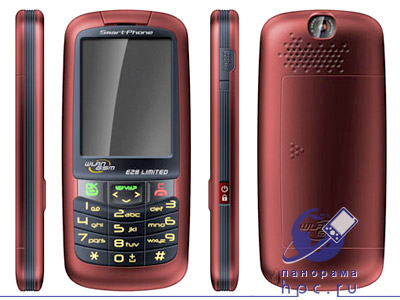 |
Clamshell E2861 and E2862 are equipped with 1.8-inch display, 64MB of ROM and RAM. E2862 additionally has a slot for flash cards microSD, and 1.3-megapixel camera. Model E2881 produces more solid impression - a 2.8-inch display, which, incidentally, is placed vertically instead of horizontally as in many modern monoblock with QWERTY-keyboard. In addition, it is equipped with a 2-megapixel camera and a GPS-receiver, but otherwise he repeats some of the previous models - CPU TI OMAP 730, 64MB of ROM and RAM, microSD card slot support for Bluetooth 1.2.
The authors, translation:
